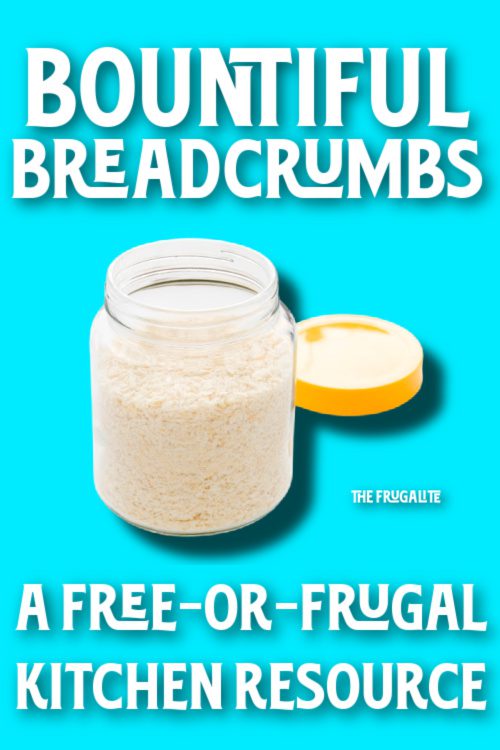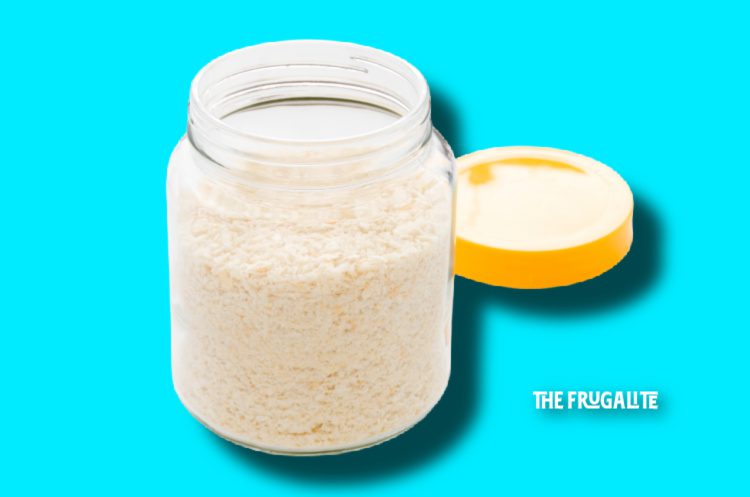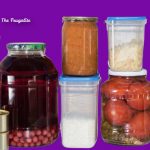(Psst: The FTC wants me to remind you that this website contains affiliate links. That means if you make a purchase from a link you click on, I might receive a small commission. This does not increase the price you’ll pay for that item nor does it decrease the awesomeness of the item. ~ Daisy)
By Marie Hawthorne
I considered myself a thrift mistress for a long time. And then, a few years ago, I bought William Woys Weaver’s cookbook Dutch Treats and was amazed at how many recipes called for breadcrumbs. In Pennsylvania Dutch kitchens, it was normal to brush off cutting boards and save the crumbs for use in various recipes. I spent years tossing breadcrumbs in the compost heap without thinking about it, but it turns out they’re a versatile resource that can be used in all kinds of cooking.
I used to make a lot of breaded meat-type meals, using the seasoned bread crumbs that come in boxes. Then, upon reading the labels, I realized there were things in there that I didn’t want to eat. So I looked for the organic bread crumbs at my store, and a small box that would only provide two or three meals’ worth of bread crumbs was four dollars. When I make my bread crumbs in bulk now, I make more than ten times the amount available in those little boxes at the store. And they are free, or close to it.
How to get more breadcrumbs
If you bake your own bread and slice your own loaves, you’ll find this generates plenty of breadcrumbs. If you don’t, however, there are other ways to obtain them.
Some bakeries sell day-old loaves at steep discounts. Grocery stores and bakeries throw out large amounts of bread that have gone slightly stale. Do you know someone that runs a bakery, either an independent one or one attached to a grocery store? If you do, sometimes you can obtain large amounts of stale bread very cheaply or for free.
Once in a while, I get large quantities of partly stale bread. Sometimes you can revive a loaf by sprinkling a little water on it and putting it in the oven for a short time, but I usually turn most of the bread into breadcrumbs. Properly dried, they keep in my pantry for a year.
How to preserve your breadcrumbs
So, how does one prepare stale bread in a way that will let it keep for such a long time?
Well, it depends on your climate. I live in a semi-arid steppe. Most of the year, I can slice old loaves into a few big chunks and then just let them sit for a few days. If I want to dry them out right away, I can put the chunks in the oven at 200 degrees, and in about 2 hours, they are not only dry but also pleasantly toasted.
However, if you live in a humid climate, just slice the bread and dry it in the oven as soon as you get it. And plan for the oven-drying time to take longer. You’ll need to check it periodically. When it’s rock hard, it’s ready.
If you live in a humid climate and you intend to keep bread crumbs from your own cutting board, I would keep odds and ends in the freezer until I was ready to oven-dry a large amount. I lived in Houston for a while. Between bugs and mold, nothing keeps unless it is absolutely dry and sealed.
Once the bread is bone dry and has cooled off, you can either put it in a bag and crush it with a rolling pin or use a food processor to grind it into crumbs. I use a food processor, and it goes very quickly. I store the finished breadcrumbs in glass jars and have kept them for more than a year.
How to use breadcrumbs
You might think that this sounds like a lot of work for an obscure ingredient, though it’s mostly just waiting for the breadcrumbs to be done in the oven. Bread crumbs don’t have to be obscure. You can use them in a variety of recipes. Here are some of my favorites.
Breaded pork chops: For four pork chops, I use about a half cup of bread crumbs and one to two teaspoons of seasoning, usually Lawry’s seasoned salt or Slap Ya Mama.
Brown Betty: I use a recipe very similar to this one. And you can use whatever fruit you have available, too. We use peaches in the summertime and apples in the winter.
Casserole topping: Do you have casserole recipes that call for crushed crackers or potato chips on top? You can use bread crumbs instead. I’ve never liked potato chips in casseroles, but if I have a recipe in which I would normally use crushed saltines or oyster crackers, I just add breadcrumbs with some extra salt. The taste and texture are very similar. (For more information, check out Daisy’s article on The Ultimate Frugal Casserole Formula.)
Saltine substitute: I don’t know about everyone else’s grocery stores, but mine had a strange spike in saltine prices for a few months. They went from $1.50 per box to $4.50. They’ve since come down, but I started experimenting with different substitutions and found that, most of the time, bread crumbs make a decent substitute.
How to Make Bread Crumb Pie
My household’s favorite recipe, though, is Bread Crumb Pie. This is loosely based off Weaver’s Poor House Pie recipe in his book Dutch Treats, which was historically made with hard tack and served at poor houses. I experimented with substitutions and simplified it a little bit. Weaver’s recipe has a superb texture; mine is a little more crumbly but my kids and I really like it anyway.
Ingredients:
- unbaked pie crust
- 2 cups bread crumbs
- 1 cup leftover mashed potatoes
- ½ cup flour
- 1 tbsp baking powder
- ½ tsp salt
- 1/3 cup white sugar
- 6 tbsp unsalted butter
- 2 eggs
- 1 cup sour cream
- 2 tbsp brown sugar, or maple sugar if available
Directions
- Line a 9-inch pie plate with an uncooked crust and preheat your oven to 375 degrees.
- Put the bread crumbs and mashed potatoes together in a large bowl and thoroughly mix them together with your hands. In a separate bowl, sift together the flour, baking powder, salt, and white sugar. Then cut in butter with a pastry blender until the pieces are pea-sized. Mix this in with the crumb mixture, and reserve one cup.
- In another bowl (you can reuse the one that had the flour mixture), beat the eggs and sour cream together until frothy, then fold into the crumb mixture. Put this into the prepared pie plate. Scatter the reserved crumb mix over the top, then scatter the brown (or maple) sugar over that. Bake for 30 to 35 minutes.
This is part side dish, part dessert. We often have it with stew at my house, but it would go well with coffee, too. I like it because it’s mostly made with leftovers; my kids like it because it has a surprisingly pleasant taste.
Breadcrumbs are a bonus!
Tasty, homemade meals are a great way to add a little joy to your day, along with keeping your household healthy and saving money. Prices have been unstable enough lately that most of us need to carefully monitor our food dollars. Breadcrumbs are often overlooked but can be used to stretch all kinds of meals.
Do you use breadcrumbs in your kitchen? Do you make your own or do you buy them? What is your favorite use for breadcrumbs? Let’s talk about it in the comments section.
About Marie Hawthorne
A lover of novels and cultivator of superb apple pie recipes, Marie spends her free time writing about the world around her.












3 thoughts on “Bountiful Breadcrumbs: A Free-Or-Frugal Kitchen Resource”
Thanks for the reminder that I should be making my own breadcrumbs in bulk! I usually substitute cracker crumbs, or make them as I need them – this method would be so much better.
I used to have no idea what I’d use breadcrumbs for but have since discovered that they really do help with things like binding meatballs. Great idea to use day old bread – or wait till the store has one of those crazy sales on cheap bread and then buy fiver or ten loaves. Could use the same principle for stuffing croutons.
There’s one other source for breadcrumbs however! Wait till after Passover, or maybe a little after that – up till early summer, maybe. You can sometimes find cheap matzoh crackers or better yet, cans of matzoh meal. That’s just ground up matzoh crackers so it makes a fine breadcrumb substitute. As a bonus, the matzoh meal is usually shelf stable!
I have used breadcrumbs for meatloaf, meatballs, pork chops, chicken-fried steak, chicken parmesan, and many other things over the years. I wish I had seen your ideas 30 years ago! I’ll definitely be using them going forward. Great article!